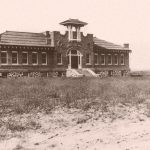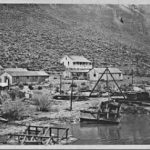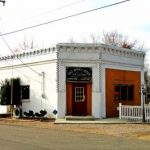Historic Ada County Cities
You’ve likely heard of or seen streets and other places named after these former cities that once existed.
Barber: The Barber dam, mill, power plant, and company town were built by the Barber Lumber Company between 1904 and 1906 to process timber harvested north of Boise along Grimes and Mores Creek. In 1913, the Barber Lumber Company merged with the Payette Lumber Company, and a year later they constructed a narrow-gauge railroad between Barber and Centerville to transport the timber to the mill. The mill remained in operation until hardships of the Great Depression forced the closure and dismantling of the mill in 1934. Today only the powerhouse and dam remain. The site was listed on the National Register of Historic Places in 1978. (Photo: Barber Saw Mill, 1941. ISHS 60-51.2)

Mora: The Town of Mora was located on the trail to Silver City and was settled between 1907 and 1909. Enough families settled in the area to support a school, and the Mora Schoolhouse was constructed in 1910, for $2,900. The school closed in the mid-1950s due to well contamination, and the building was sold in 1966 for $2,200. The Schoolhouse, located on Kuna-Mora Road, is one of the few remaining Mora structures still standing today. (Photo: Mora Schoolhouse, Dr. Doug Rutan)

Orchard: The Townsite of Orchard was platted in 1895, and was the location of a railroad siding and intersection of the Boise Main Line Track. The town, previously called “Bisuka,” was named after a large orchard on the site maintained by water from Indian Creek. One of the few remaining structures is a one-room schoolhouse which served local families from the early 1900s until 1966 when it was closed by the Boise School District. The Townsite is located south of the Mayfield/Orchard Interchange on I-84 (Exit 71) near the Elmore County Line. (Photo: Orchard Schoolhouse, 1989.)

Swan Falls Village: The Village at Swan Falls was established to support those who helped with the construction and operation of the Swan Falls Dam and Power Plant. The original Dam and Power Plant were constructed in 1900 and designed by A. J. Wiley, a young Engineer from Boise. In 1907 a power plant was built east of the original to support the Boise and Interurban Railroads. In 1910 another plant was constructed west of the original and in 1911-13 the original plant was replaced by a more modern structure. These three buildings can still be seen today. The Dam and Power Plant were listed on the National Register of Historic Places on July 6, 1976. (Photo: Swan Falls Village, 1911. HABS)

Ustick: The Townsite of Ustick was established in 1907 by Dr. Harlan P. Ustick. The town supported a school, a bank,a store, a church, a creamery and vinegar processing plants. Up until the 1920’s Ustick was a flourishing agricultural region within Ada County. It was home to some of the largest apple orchards found in the Northwest. Many of the original structures remain today. (Photo: Ustick Bank, 2013)

